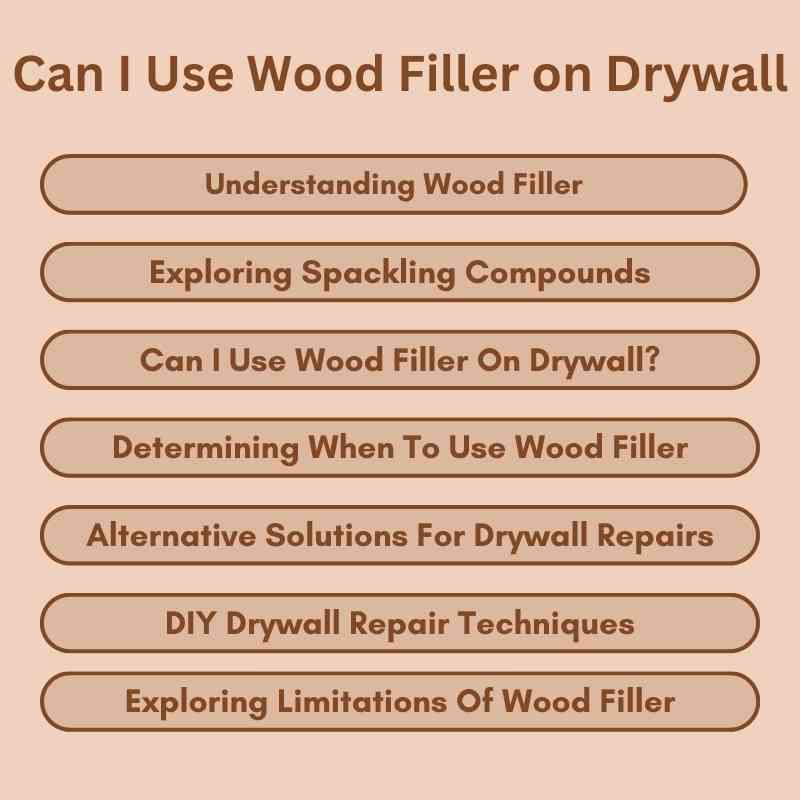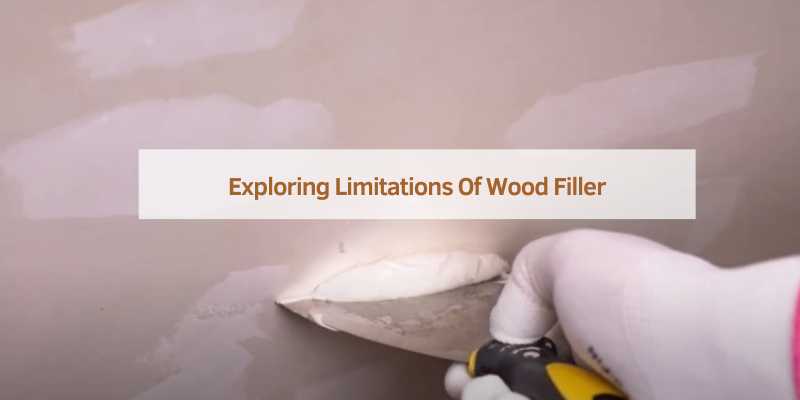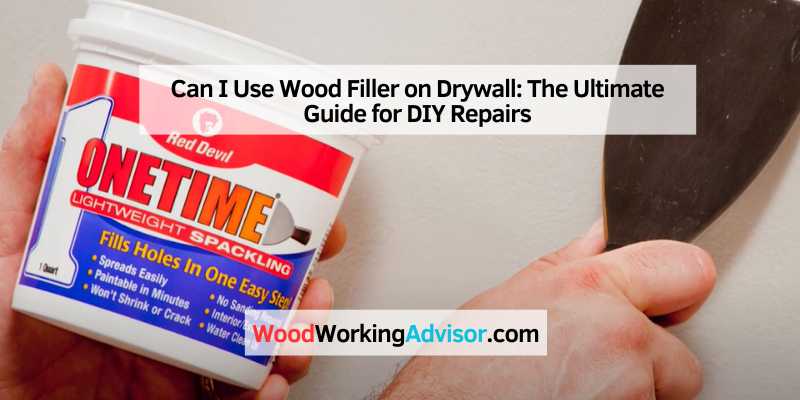Yes, you can use wood filler on drywall, but it may not be the best option as it dries too hard for a plaster wall. It’s essential to choose the right filler depending on the substrate hardness.
For wood projects, wood filler is ideal, while for drywall repairs, spackle is the recommended choice. Wood filler is specifically designed for wooden surfaces and woodworking projects, providing a sturdy and durable finish. On the other hand, spackle is more suitable for drywall repairs, seamlessly filling in cracks and imperfections.
Understanding the key differences between the two fillers will help you achieve the best results for your specific project needs.
Understanding Wood Filler
Understanding wood filler is essential when it comes to addressing imperfections on your drywall. Whether you’re dealing with nail holes, scratches, or cracks, wood filler can be a versatile solution for achieving a smooth and seamless surface. In this section, we will explore what wood filler is, the best wood filler products available, and specifically, the Gorilla All Purpose Wood Filler.
H3 Heading: What is Wood Filler?
What Is Wood Filler?
Wood filler is a versatile product designed to fill gaps and repair damaged or uneven surfaces in wood. It is a putty-like material that can be applied to various wooden surfaces such as furniture, trims, and flooring to mask imperfections and provide a smooth finish. Wood filler consists of a mixture of wood fibers and a binding agent, typically a type of resin. This combination allows the filler to adhere firmly to the wood and create a solid, durable surface once it dries.
Best Wood Filler Products
When it comes to choosing the best wood filler product for your drywall repairs, there are several options available in the market. It’s important to select a wood filler that is compatible with drywall materials and offers excellent adhesion and durability. Here are some top-rated wood filler products:
| Product | Description | Rating |
|---|---|---|
| Gorilla All Purpose Wood Filler | Gorilla All Purpose Wood Filler is a high-quality option that works well on both interior and exterior wood surfaces. It offers excellent adhesion and is resistant to shrinking and cracking. | 4.5/5 |
| Woodwise Wood Filler | Woodwise Wood Filler is a water-based wood filler that is easy to use and dries quickly. It is ideal for filling small cracks and minor imperfections in wood. | 4/5 |
| Elmer’s Carpenter’s Wood Filler | Elmer’s Carpenter’s Wood Filler is a popular choice for its affordability and ease of use. It dries quickly and can be sanded, painted, or stained for a seamless finish. | 4/5 |
Products: Gorilla All Purpose Wood Filler
Gorilla All Purpose Wood Filler is a highly recommended wood filler product that delivers exceptional results on drywall repairs. This wood filler is specifically formulated to work well on both interior and exterior wood surfaces, making it a versatile option. It offers superior adhesion, ensuring a long-lasting and durable finish.
One of the standout features of Gorilla All Purpose Wood Filler is its resistance to shrinking and cracking. This means that once applied, the filler maintains its integrity and doesn’t succumb to temperature fluctuations or other environmental factors. Additionally, this wood filler is easy to sand, allowing for smooth and seamless finishing touches on your drywall.
Overall, Gorilla All Purpose Wood Filler is a reliable choice for anyone looking to repair drywall imperfections. Its high-quality formulation and exceptional performance make it a top contender in the world of wood fillers.

Exploring Spackling Compounds
Best Spackling Compounds
When it comes to repairing drywall, choosing the right spackling compound is essential for achieving a seamless finish.
Red Devil One-time Lightweight Spackle
Red Devil One-Time Lightweight Spackle is a popular choice due to its quick-drying formula and easy application. It is ideal for filling small holes and cracks in drywall with minimal shrinkage.
Can I Use Wood Filler On Drywall?
Wood filler is not suitable for drywall repairs as it is formulated for use on wood surfaces. It may not adhere well to drywall and could crack or shrink over time. It’s best to use spackle for drywall repairs, as it is specifically designed for this purpose and provides a smoother finish.
Wood filler is a versatile product commonly used in woodworking projects to fill nail holes, cracks, and blemishes in wood surfaces. However, many people wonder if wood filler can also be used on drywall. Let’s delve into this topic to understand whether wood filler is suitable for drywall applications.
Wood Filler vs. Spackle: Key Differences
When it comes to repairing drywall, it’s essential to understand the key differences between wood filler and spackle. Each product is designed for specific applications, and knowing these differences can help you make an informed decision when tackling drywall repairs.
Wood filler is formulated for use on wood surfaces, making it ideal for repairing wood trim, filling imperfections in wooden surfaces, and addressing woodworking-related projects. The composition and texture of wood filler are tailored to adhere and seamlessly blend with wood materials, ensuring a durable and natural-looking finish.
On the other hand, spackle is specifically designed for drywall repairs. It is a lightweight compound that is easy to apply and dries quickly, making it suitable for filling small holes, cracks, and imperfections in drywall surfaces. Spackle is formulated to achieve a smooth and seamless finish on drywall, providing an ideal surface for painting and finishing.
In summary, the key difference between wood filler and spackle lies in their intended use and compatibility with different surfaces. While wood filler is suitable for wood-related projects, spackle is the preferred choice for repairing drywall due to its composition and application-specific properties. Understanding these differences can help you choose the right product for your specific repair needs.
In conclusion, while wood filler is not recommended for use on drywall due to its intended purpose and properties, utilizing spackle for drywall repairs can ensure a seamless and professional-looking finish. By selecting the appropriate product for your surface, you can achieve optimal results and effectively address any imperfections in wood or drywall surfaces.
Determining When To Use Wood Filler
When considering whether to use wood filler on drywall, it’s important to assess the type and extent of the damage to the wall. Wood filler can be particularly useful for repairing larger holes, gaps, or imperfections in drywall, providing a sturdy and durable solution for uneven surfaces.
Wood Filler Vs. Spackle For Drywall Repairs
Wood filler and spackle have distinct purposes for drywall repairs. Wood filler is designed for use on wood surfaces. It is best suited for filling in large holes, gaps, or imperfections on drywall, particularly ones that need support due to its structural properties. On the other hand, spackle is specifically formulated for drywall repairs, offering a more lightweight and flexible solution for minor blemishes and smaller imperfections on the surface.
When Should You Not Use Wood Filler?
Wood filler should not be used in outdoor settings, as it is prone to shrinkage and cracking, especially in response to temperature fluctuations. Additionally, for plaster walls, wood filler can dry too hard and may not adhere effectively. Therefore, it is essential to avoid using wood filler on surfaces that are softer than the filler and to opt for specialized solutions such as plaster filler for plaster walls.
Alternative Solutions For Drywall Repairs
When it comes to repairing drywall, using the right filler is crucial for achieving a seamless finish. While wood filler is typically used for wood surfaces, there are alternative solutions for repairing drywall effectively.
Using Plaster Filler On Plaster Walls
If you have plaster walls that need repairs, it’s best to opt for plaster filler. Plaster filler is specifically formulated for plaster surfaces, ensuring a durable and long-lasting repair. It seamlessly blends in with the existing plaster, providing a smooth finish.
Wood Filler Vs. Spackle: Which One To Choose
Wood filler and spackle serve different purposes when it comes to drywall repairs. Here’s a breakdown of the key differences:
- Wood Filler: Designed for use on wood surfaces, wood filler is perfect for woodworking projects and addressing imperfections in wooden surfaces. Avoid using wood filler on drywall or plaster walls as it may not adhere properly.
- Spackle: Ideal for drywall repairs, spackle is formulated to fill in cracks, holes, and imperfections on drywall surfaces. It dries quickly and can be sanded down for a smooth finish.
Knowing the difference between wood filler and spackle can help you choose the right product for your specific drywall repair needs.
DIY Drywall Repair Techniques
Wood filler should not be used on drywall as it dries too hard for the surface. Opt for spackle instead, ideal for drywall repairs and filling imperfections. Ensure to use the right material for the best results in wall repairs.
Advantages Of A Hole Drill
A hole drill is a handy tool to have when it comes to repairing drywall. It offers several advantages that make the process easier and more efficient.
- Allows for precise and accurate hole cutting
- Creates clean and smooth edges
- Reduces the risk of damaging surrounding areas
- Enables easier placement of wood filler
Materials Needed
Before you begin repairing your drywall, make sure you have the following materials:
- Drywall hole drill
- Wood filler suitable for drywall
- Sanding block or sandpaper
- Putty knife or scraper
- Primer and paint for finishing
Step-by-step Guide For Repairing Drywall
Follow these steps to successfully repair your drywall using wood filler:
- Use the hole drill to create a clean hole around the damaged area.
- Remove any loose debris or particles from the hole.
- Apply the wood filler generously to fill the hole, ensuring it is level with the surface of the wall. Use a putty knife or scraper to spread the filler evenly.
- Allow the wood filler to dry completely according to the manufacturer’s instructions.
- Once dry, use a sanding block or sandpaper to smooth the surface of the filler until it blends seamlessly with the surrounding wall.
- Wipe away any dust or debris from sanding.
- Apply a layer of primer to the repaired area to ensure even paint coverage.
- After the primer has dried, you can paint the repaired area to match the rest of the wall.
By following these simple steps and utilizing a hole drill, you can effectively repair drywall using wood filler.
Exploring Limitations Of Wood Filler
When it comes to filling cracks on drywall, it is not recommended to use wood filler. Wood filler is specifically designed for use on wood surfaces and may not adhere well on drywall. It is best to use spackle or drywall compound for repairing drywall imperfections.
Wood Filler Not Suitable For Exterior Use
If you’re considering using wood filler on drywall for an exterior application, you may want to think again. Wood filler is not suitable for outdoor use, as it is prone to shrinking and cracking, especially when exposed to temperature fluctuations. Instead, opt for a wood filler specifically designed for both interior and exterior applications, such as certain two-part wood fillers that contain special hardeners to prevent shrinkage and cracking.
Adhesion Issues With Stained Or Painted Surfaces
When it comes to using wood filler on drywall with stained or painted surfaces, adhesion can be an issue. Wood filler is typically formulated to adhere to raw wood surfaces, and may not bond well to stained or painted surfaces. This can result in the filler not adhering properly and eventually cracking or peeling off. To ensure proper adhesion, it is recommended to use a filler that is specifically formulated for use on painted or stained surfaces. These fillers often have additives that enhance adhesion to previously finished surfaces.

Frequently Asked Questions For Can I Use Wood Filler On Drywall
Can I Use Wood Filler On A Wall?
No, you should not use wood filler on a wall. Wood filler dries too hard and is not suitable for plaster walls. Only use plaster filler on plaster surfaces.
Can I Use Wood Filler Instead Of Spackle?
You should use spackle for drywall repairs, as wood filler is intended for wood surfaces.
When Should You Not Use Wood Filler?
Wood filler should not be used outdoors due to its susceptibility to shrink and crack, especially in fluctuating temperatures. It’s also not suitable for plaster walls or for filling cracks on walls. Additionally, it doesn’t adhere well to stained or painted finishes.
For these applications, it’s best to use the appropriate alternatives.
What Does Wood Filler Not Stick To?
Wood filler does not stick to exterior surfaces, stained or painted finishes, and materials softer than the filler.
Conclusion
After exploring the uses of wood filler and drywall, it’s clear that each has its specific applications. When deciding between caulk, spackle, or wood filler, consider the material and purpose. Remember, wood filler is best for wood, while spackle is ideal for drywall repairs.
Choose wisely for optimal results.


